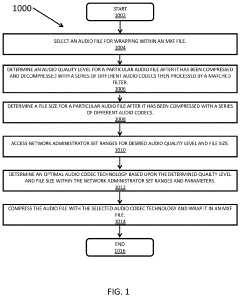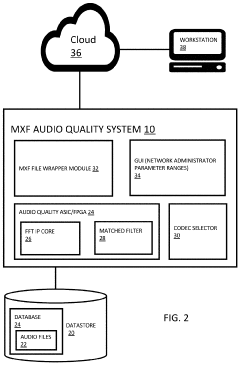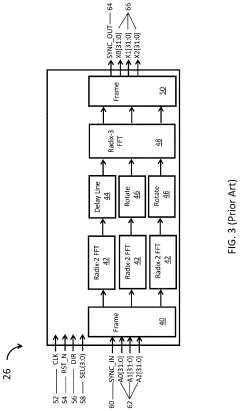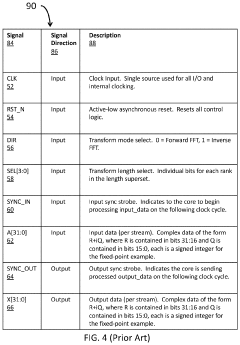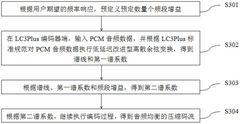LDAC vs. AptX: Which is Supreme in Audio Quality?
JUL 4, 20258 MIN READ
Generate Your Research Report Instantly with AI Agent
Patsnap Eureka helps you evaluate technical feasibility & market potential.
LDAC and AptX Overview
LDAC and AptX are two prominent audio codecs designed to enhance the quality of wireless audio transmission, particularly in Bluetooth devices. These technologies have emerged as solutions to the limitations of standard Bluetooth audio, which often struggles to deliver high-fidelity sound due to bandwidth constraints.
LDAC, developed by Sony, is a proprietary audio coding technology that aims to deliver high-resolution audio wirelessly. It supports up to 24-bit/96kHz audio transmission at a maximum bitrate of 990 kbps. This codec utilizes adaptive bit rate technology, allowing it to adjust its transmission rate based on the wireless environment, ensuring optimal performance and stability.
AptX, on the other hand, is a family of audio codecs created by Qualcomm. The original AptX codec offered CD-like quality audio at 352 kbps, while newer variants such as AptX HD support 24-bit/48kHz audio at 576 kbps. AptX Adaptive, the latest iteration, can dynamically adjust its bitrate between 279 kbps and 420 kbps to balance audio quality and connection stability.
Both codecs employ advanced compression algorithms to maximize audio quality within the constraints of Bluetooth bandwidth. LDAC uses a hybrid coding scheme that combines lossless and lossy compression techniques, while AptX utilizes psychoacoustic modeling to achieve efficient compression with minimal perceptible loss in audio quality.
The primary goal of these codecs is to bridge the gap between wired and wireless audio quality. They aim to provide audiophiles and discerning listeners with a wireless listening experience that closely approximates or even matches the fidelity of wired connections. This is particularly important as consumer preferences shift towards wireless audio solutions in various scenarios, from personal listening to home entertainment systems.
In terms of device support, AptX has a broader ecosystem, being widely adopted by many smartphone manufacturers and audio device makers. LDAC, while initially exclusive to Sony products, has been made available as part of the Android Open Source Project since Android 8.0, increasing its potential for wider adoption.
Both LDAC and AptX continue to evolve, with ongoing research and development focused on improving audio quality, reducing latency, and enhancing energy efficiency. These advancements are crucial in the context of emerging technologies such as true wireless stereo (TWS) earbuds and high-fidelity streaming services, where the demand for superior wireless audio quality is ever-increasing.
LDAC, developed by Sony, is a proprietary audio coding technology that aims to deliver high-resolution audio wirelessly. It supports up to 24-bit/96kHz audio transmission at a maximum bitrate of 990 kbps. This codec utilizes adaptive bit rate technology, allowing it to adjust its transmission rate based on the wireless environment, ensuring optimal performance and stability.
AptX, on the other hand, is a family of audio codecs created by Qualcomm. The original AptX codec offered CD-like quality audio at 352 kbps, while newer variants such as AptX HD support 24-bit/48kHz audio at 576 kbps. AptX Adaptive, the latest iteration, can dynamically adjust its bitrate between 279 kbps and 420 kbps to balance audio quality and connection stability.
Both codecs employ advanced compression algorithms to maximize audio quality within the constraints of Bluetooth bandwidth. LDAC uses a hybrid coding scheme that combines lossless and lossy compression techniques, while AptX utilizes psychoacoustic modeling to achieve efficient compression with minimal perceptible loss in audio quality.
The primary goal of these codecs is to bridge the gap between wired and wireless audio quality. They aim to provide audiophiles and discerning listeners with a wireless listening experience that closely approximates or even matches the fidelity of wired connections. This is particularly important as consumer preferences shift towards wireless audio solutions in various scenarios, from personal listening to home entertainment systems.
In terms of device support, AptX has a broader ecosystem, being widely adopted by many smartphone manufacturers and audio device makers. LDAC, while initially exclusive to Sony products, has been made available as part of the Android Open Source Project since Android 8.0, increasing its potential for wider adoption.
Both LDAC and AptX continue to evolve, with ongoing research and development focused on improving audio quality, reducing latency, and enhancing energy efficiency. These advancements are crucial in the context of emerging technologies such as true wireless stereo (TWS) earbuds and high-fidelity streaming services, where the demand for superior wireless audio quality is ever-increasing.
Market Demand Analysis
The market demand for high-quality audio codecs like LDAC and aptX has been steadily increasing, driven by the growing popularity of wireless audio devices and consumers' desire for superior sound quality. As more users transition from wired to wireless audio solutions, the importance of advanced Bluetooth codecs has become paramount in delivering a premium listening experience.
The global wireless audio market has experienced significant growth, with a particular emphasis on high-fidelity audio transmission. This trend is evident in the increasing adoption of wireless headphones, earbuds, and speakers that support advanced audio codecs. Consumers are becoming more discerning about audio quality, seeking solutions that can deliver near-lossless audio over Bluetooth connections.
LDAC and aptX, both developed to address the limitations of standard Bluetooth audio compression, have gained substantial traction in the market. These codecs cater to audiophiles and casual listeners alike who demand better sound quality from their wireless devices. The market has seen a surge in products featuring these advanced codecs, with many flagship smartphones and high-end audio devices incorporating support for LDAC, aptX, or both.
The demand for these advanced audio codecs is closely tied to the broader trends in the consumer electronics industry. As smartphones continue to eliminate headphone jacks, the need for high-quality wireless audio solutions becomes more pressing. This shift has created a robust ecosystem of wireless audio products, with manufacturers competing to offer the best possible sound quality through advanced codec support.
In the professional audio sector, there is also a growing interest in high-quality wireless audio transmission. Studios, live performance venues, and broadcast environments are exploring ways to incorporate wireless audio solutions without compromising on sound quality. This has opened up new market opportunities for LDAC and aptX in professional-grade audio equipment.
The automotive industry represents another significant market for advanced audio codecs. As car manufacturers focus on enhancing in-vehicle entertainment systems, the demand for high-quality wireless audio streaming has increased. This has led to the integration of advanced Bluetooth codecs in car infotainment systems, further expanding the market reach of LDAC and aptX.
Consumer awareness and education about audio quality have played a crucial role in driving market demand. As users become more knowledgeable about the technical aspects of audio transmission, they are more likely to seek out devices that support advanced codecs. This has prompted manufacturers to prominently feature codec support in their product marketing, highlighting the audio quality advantages of LDAC and aptX.
The market demand analysis indicates a clear trend towards higher quality audio in wireless devices, with LDAC and aptX positioned as key technologies in meeting this demand. As the wireless audio market continues to evolve, the competition between these advanced codecs is likely to intensify, driving further innovation and improvements in audio quality for consumers across various sectors.
The global wireless audio market has experienced significant growth, with a particular emphasis on high-fidelity audio transmission. This trend is evident in the increasing adoption of wireless headphones, earbuds, and speakers that support advanced audio codecs. Consumers are becoming more discerning about audio quality, seeking solutions that can deliver near-lossless audio over Bluetooth connections.
LDAC and aptX, both developed to address the limitations of standard Bluetooth audio compression, have gained substantial traction in the market. These codecs cater to audiophiles and casual listeners alike who demand better sound quality from their wireless devices. The market has seen a surge in products featuring these advanced codecs, with many flagship smartphones and high-end audio devices incorporating support for LDAC, aptX, or both.
The demand for these advanced audio codecs is closely tied to the broader trends in the consumer electronics industry. As smartphones continue to eliminate headphone jacks, the need for high-quality wireless audio solutions becomes more pressing. This shift has created a robust ecosystem of wireless audio products, with manufacturers competing to offer the best possible sound quality through advanced codec support.
In the professional audio sector, there is also a growing interest in high-quality wireless audio transmission. Studios, live performance venues, and broadcast environments are exploring ways to incorporate wireless audio solutions without compromising on sound quality. This has opened up new market opportunities for LDAC and aptX in professional-grade audio equipment.
The automotive industry represents another significant market for advanced audio codecs. As car manufacturers focus on enhancing in-vehicle entertainment systems, the demand for high-quality wireless audio streaming has increased. This has led to the integration of advanced Bluetooth codecs in car infotainment systems, further expanding the market reach of LDAC and aptX.
Consumer awareness and education about audio quality have played a crucial role in driving market demand. As users become more knowledgeable about the technical aspects of audio transmission, they are more likely to seek out devices that support advanced codecs. This has prompted manufacturers to prominently feature codec support in their product marketing, highlighting the audio quality advantages of LDAC and aptX.
The market demand analysis indicates a clear trend towards higher quality audio in wireless devices, with LDAC and aptX positioned as key technologies in meeting this demand. As the wireless audio market continues to evolve, the competition between these advanced codecs is likely to intensify, driving further innovation and improvements in audio quality for consumers across various sectors.
Technical Challenges
The technical challenges in comparing LDAC and aptX audio codecs primarily revolve around the complexities of audio compression and transmission in Bluetooth environments. Both codecs aim to deliver high-quality audio over limited bandwidth, but they face several hurdles in achieving this goal.
One of the main challenges is balancing audio quality with transmission efficiency. LDAC, developed by Sony, offers variable bitrates up to 990 kbps, while aptX, created by Qualcomm, typically operates at 352 kbps. The higher bitrate of LDAC potentially allows for better audio quality, but it also requires more bandwidth and power consumption. This trade-off between quality and efficiency is a constant struggle in codec development.
Another significant challenge is maintaining consistent performance across different devices and environments. Bluetooth connections are susceptible to interference from other wireless signals, physical obstacles, and distance between devices. Both LDAC and aptX must implement robust error correction and adaptive bitrate mechanisms to ensure stable audio playback under varying conditions.
Latency is a critical issue, especially for applications like gaming or video playback. While both codecs have made strides in reducing latency, achieving imperceptible delay while maintaining high audio quality remains a technical challenge. This is particularly crucial for aptX, which has variants like aptX Low Latency specifically designed to address this issue.
Compatibility across devices poses another challenge. While LDAC is open-source and part of the Android Open Source Project, it is not as widely supported as aptX. The fragmentation of the Bluetooth audio ecosystem, with multiple codecs and versions, creates complexity for both manufacturers and consumers.
Power consumption is a significant concern, especially for portable devices. Higher quality audio transmission typically requires more processing power and energy. Balancing audio quality with battery life is a constant challenge for both LDAC and aptX developers.
Finally, there's the challenge of perceptual audio quality. While technical specifications can be measured objectively, the subjective nature of audio perception makes it difficult to definitively claim superiority. Factors like individual hearing capabilities, listening environments, and personal preferences all play a role in perceived audio quality, complicating the comparison between LDAC and aptX.
One of the main challenges is balancing audio quality with transmission efficiency. LDAC, developed by Sony, offers variable bitrates up to 990 kbps, while aptX, created by Qualcomm, typically operates at 352 kbps. The higher bitrate of LDAC potentially allows for better audio quality, but it also requires more bandwidth and power consumption. This trade-off between quality and efficiency is a constant struggle in codec development.
Another significant challenge is maintaining consistent performance across different devices and environments. Bluetooth connections are susceptible to interference from other wireless signals, physical obstacles, and distance between devices. Both LDAC and aptX must implement robust error correction and adaptive bitrate mechanisms to ensure stable audio playback under varying conditions.
Latency is a critical issue, especially for applications like gaming or video playback. While both codecs have made strides in reducing latency, achieving imperceptible delay while maintaining high audio quality remains a technical challenge. This is particularly crucial for aptX, which has variants like aptX Low Latency specifically designed to address this issue.
Compatibility across devices poses another challenge. While LDAC is open-source and part of the Android Open Source Project, it is not as widely supported as aptX. The fragmentation of the Bluetooth audio ecosystem, with multiple codecs and versions, creates complexity for both manufacturers and consumers.
Power consumption is a significant concern, especially for portable devices. Higher quality audio transmission typically requires more processing power and energy. Balancing audio quality with battery life is a constant challenge for both LDAC and aptX developers.
Finally, there's the challenge of perceptual audio quality. While technical specifications can be measured objectively, the subjective nature of audio perception makes it difficult to definitively claim superiority. Factors like individual hearing capabilities, listening environments, and personal preferences all play a role in perceived audio quality, complicating the comparison between LDAC and aptX.
Current Implementation
01 LDAC and AptX codec implementation
LDAC and AptX are advanced audio codecs used in Bluetooth devices to improve audio quality. These codecs offer higher bitrates and better compression algorithms compared to standard Bluetooth audio, resulting in improved sound fidelity and reduced latency. Implementation of these codecs in audio devices can significantly enhance the overall listening experience.- Audio codec comparison and implementation: LDAC and aptX are advanced audio codecs used in Bluetooth audio transmission. They offer higher bitrates and better audio quality compared to standard codecs. The implementation of these codecs in audio devices involves specific encoding and decoding algorithms to optimize sound quality while maintaining efficient wireless transmission.
- Adaptive bit rate and audio quality optimization: These codecs employ adaptive bit rate techniques to adjust audio quality based on connection stability and device capabilities. This allows for dynamic optimization of audio quality in various environments, ensuring the best possible sound experience while maintaining a stable connection.
- Low latency audio transmission: LDAC and aptX codecs are designed to minimize audio latency in wireless transmission. This is crucial for applications such as gaming and video playback, where synchronization between audio and visual elements is essential. The codecs employ various techniques to reduce processing time and maintain low latency.
- Integration with audio processing systems: The integration of LDAC and aptX codecs with various audio processing systems is explored to enhance overall audio quality. This includes combining the codecs with noise cancellation technologies, spatial audio processing, and other audio enhancement techniques to provide a superior listening experience.
- Compatibility and device support: Ensuring compatibility of LDAC and aptX codecs across different devices and platforms is crucial for widespread adoption. This involves developing standardized implementations, creating software development kits (SDKs) for easy integration, and working with device manufacturers to ensure proper support and optimization for these advanced audio codecs.
02 Audio quality optimization techniques
Various techniques are employed to optimize audio quality in wireless transmission systems. These may include adaptive bit rate allocation, dynamic range compression, and spectral shaping. Such techniques aim to maintain high audio quality while efficiently utilizing available bandwidth and adapting to changing network conditions.Expand Specific Solutions03 Bluetooth audio transmission improvements
Advancements in Bluetooth technology focus on improving audio transmission quality. This includes the development of new Bluetooth profiles, enhanced error correction methods, and improved synchronization techniques. These improvements aim to reduce audio artifacts, minimize latency, and provide a more stable connection for high-quality audio streaming.Expand Specific Solutions04 Audio processing for wireless systems
Specialized audio processing techniques are developed for wireless audio systems to enhance sound quality. These may include noise reduction algorithms, spatial audio processing, and psychoacoustic enhancements. Such processing aims to compensate for limitations in wireless transmission and improve the perceived audio quality on the receiving end.Expand Specific Solutions05 Compatibility and interoperability of audio codecs
Ensuring compatibility and interoperability between different audio codecs and devices is crucial for widespread adoption of high-quality audio technologies. This involves developing standardized interfaces, negotiation protocols, and fallback mechanisms to ensure seamless operation across various devices and platforms supporting different codec implementations.Expand Specific Solutions
Key Industry Players
The competition in LDAC vs. AptX audio quality is at a mature stage, with established players dominating the market. The global Bluetooth audio codec market is projected to reach significant size, driven by increasing demand for high-quality wireless audio. Technologically, both LDAC and AptX are advanced, with companies like Sony (LDAC developer) and Qualcomm (AptX owner) leading innovation. Other key players include Apple, Huawei, and Fraunhofer-Gesellschaft, each contributing to codec development. The market is characterized by ongoing improvements in audio quality, latency reduction, and energy efficiency, with companies like Analog Devices and Cirrus Logic providing essential components for implementation.
Huawei Technologies Co., Ltd.
Technical Solution: Huawei has developed its own high-resolution Bluetooth audio codec called HWA (Hi-Res Wireless Audio). HWA supports audio transmission up to 990 kbps, similar to LDAC[8]. The codec uses adaptive bit rate technology to maintain stable connections and optimize audio quality based on environmental conditions. Huawei has implemented HWA in its smartphones and audio devices, aiming to create a comprehensive ecosystem for high-quality wireless audio. The company has also been working on improving Bluetooth connectivity and stability through its Kirin chipsets, which integrate advanced Bluetooth features[9].
Strengths: High bit rate support, adaptive performance, integration with Huawei devices. Weaknesses: Limited adoption outside Huawei ecosystem, potential compatibility issues with non-Huawei devices.
Apple, Inc.
Technical Solution: Apple has developed its own proprietary codec, AAC (Advanced Audio Coding), which is widely used in its ecosystem. While not directly comparable to LDAC or aptX, AAC offers high-quality audio transmission at lower bit rates, typically around 256 kbps[5]. Apple's implementation focuses on efficiency and compatibility across its devices, including iPhones, iPads, and AirPods. The company has optimized AAC for low latency and power consumption, making it suitable for various applications, from music streaming to video calls[6]. Apple has also introduced Bluetooth audio sharing features, allowing multiple AirPods to connect to a single device simultaneously[7].
Strengths: Seamless integration within Apple ecosystem, efficient power usage, wide device support. Weaknesses: Lower maximum bit rate compared to LDAC and aptX HD, limited compatibility outside Apple devices.
Core Technology Review
Matched filter to selectively choose the optimal audio compression for a material exchange format file
PatentActiveUS20200118578A1
Innovation
- A system utilizing matched-filter technology to select the optimal audio codec for MXF files by analyzing the power spectrum of audio files compressed with various codecs, balancing audio quality and file size based on network administrator-defined parameters, and incorporating the selected codec within the MXF wrapper.
Audio equalization method and system of encoder end, storage medium and equipment
PatentPendingCN118782054A
Innovation
- The audio equalization function is added to the LC3Plus encoder. By predefining the frequency band gain and using the low-latency improved discrete cosine transform, the frequency response of the audio signal is adjusted to achieve the frequency response expected by the user, and the calculation of the equalizer is simplified to reduce the delay. and power consumption.
Compatibility Issues
When comparing LDAC and aptX in terms of audio quality, it's crucial to consider the compatibility issues that may arise with these Bluetooth audio codecs. Both LDAC and aptX are proprietary technologies, which means they are not universally supported across all devices and platforms.
LDAC, developed by Sony, is primarily found in Sony devices and some Android smartphones. It has limited compatibility with other brands and is not supported on iOS devices. This restriction can be a significant drawback for users who own multiple devices from different manufacturers or those who frequently switch between Android and iOS platforms.
On the other hand, aptX, created by Qualcomm, has broader compatibility across various devices and brands. It is supported by many Android smartphones, tablets, and Windows PCs. However, like LDAC, aptX is not natively supported on iOS devices, which can be a limitation for Apple users.
The compatibility issue extends beyond just the source devices. Bluetooth headphones and speakers must also support these codecs to take advantage of their higher audio quality. While many high-end audio products now support both LDAC and aptX, budget-friendly options may only support one or neither of these codecs.
Another consideration is the different versions of aptX, such as aptX HD and aptX Adaptive. These variations offer improvements in audio quality and latency but may have different compatibility requirements. Users need to ensure that both their source device and audio output device support the same version of aptX for optimal performance.
Firmware updates can sometimes add codec support to existing devices, but this is not always the case. Users may need to purchase new hardware to access these advanced codecs, which can be a significant investment.
The lack of universal compatibility can lead to a suboptimal audio experience when devices fall back to the standard SBC codec, which is universally supported but offers lower audio quality. This fallback mechanism ensures basic functionality but negates the benefits of LDAC or aptX.
In conclusion, while LDAC and aptX offer superior audio quality, their proprietary nature and varying levels of device support create compatibility challenges. Users must carefully consider their device ecosystem and future upgrade plans when choosing between these codecs to ensure a consistent high-quality audio experience across all their devices.
LDAC, developed by Sony, is primarily found in Sony devices and some Android smartphones. It has limited compatibility with other brands and is not supported on iOS devices. This restriction can be a significant drawback for users who own multiple devices from different manufacturers or those who frequently switch between Android and iOS platforms.
On the other hand, aptX, created by Qualcomm, has broader compatibility across various devices and brands. It is supported by many Android smartphones, tablets, and Windows PCs. However, like LDAC, aptX is not natively supported on iOS devices, which can be a limitation for Apple users.
The compatibility issue extends beyond just the source devices. Bluetooth headphones and speakers must also support these codecs to take advantage of their higher audio quality. While many high-end audio products now support both LDAC and aptX, budget-friendly options may only support one or neither of these codecs.
Another consideration is the different versions of aptX, such as aptX HD and aptX Adaptive. These variations offer improvements in audio quality and latency but may have different compatibility requirements. Users need to ensure that both their source device and audio output device support the same version of aptX for optimal performance.
Firmware updates can sometimes add codec support to existing devices, but this is not always the case. Users may need to purchase new hardware to access these advanced codecs, which can be a significant investment.
The lack of universal compatibility can lead to a suboptimal audio experience when devices fall back to the standard SBC codec, which is universally supported but offers lower audio quality. This fallback mechanism ensures basic functionality but negates the benefits of LDAC or aptX.
In conclusion, while LDAC and aptX offer superior audio quality, their proprietary nature and varying levels of device support create compatibility challenges. Users must carefully consider their device ecosystem and future upgrade plans when choosing between these codecs to ensure a consistent high-quality audio experience across all their devices.
User Experience Impact
The impact of LDAC and aptX on user experience is significant, as these advanced audio codecs directly influence the quality of wireless audio transmission. Both technologies aim to enhance the listening experience, but they approach this goal in slightly different ways.
LDAC, developed by Sony, offers a higher bitrate of up to 990 kbps, which theoretically allows for better audio quality. This higher bitrate can potentially provide a more detailed and nuanced sound, especially noticeable in high-resolution audio files. Users who are particularly discerning about audio quality may appreciate the additional clarity and depth that LDAC can offer.
On the other hand, aptX, created by Qualcomm, focuses on low latency and efficient compression. While it may not reach the same bitrates as LDAC, aptX and its variants (such as aptX HD and aptX Adaptive) still deliver high-quality audio with the added benefit of reduced lag. This can be particularly beneficial for users who prioritize synchronization between audio and video, such as when watching movies or playing games.
The choice between LDAC and aptX can affect different aspects of the user experience. For music enthusiasts, LDAC's higher bitrate might provide a more satisfying listening experience, especially with high-quality audio sources. However, the difference may not be as noticeable for casual listeners or those using lower-quality audio files.
In terms of device compatibility, aptX has a wider adoption across various brands and devices, which can be an advantage for users who own multiple devices from different manufacturers. LDAC, being proprietary to Sony, is more limited in its availability, which could impact the user's ability to enjoy consistent audio quality across all their devices.
Battery life is another factor that affects user experience. Higher bitrate codecs like LDAC can potentially drain battery faster than more efficient codecs. Users who prioritize long battery life might prefer aptX for its balance between quality and power consumption.
Ultimately, the impact on user experience depends on individual preferences and use cases. Audiophiles might lean towards LDAC for its potential to deliver higher quality audio, while users who value versatility and broader device compatibility might prefer aptX. The choice between the two can influence not only the perceived audio quality but also factors like battery life, device compatibility, and overall user satisfaction with their wireless audio experience.
LDAC, developed by Sony, offers a higher bitrate of up to 990 kbps, which theoretically allows for better audio quality. This higher bitrate can potentially provide a more detailed and nuanced sound, especially noticeable in high-resolution audio files. Users who are particularly discerning about audio quality may appreciate the additional clarity and depth that LDAC can offer.
On the other hand, aptX, created by Qualcomm, focuses on low latency and efficient compression. While it may not reach the same bitrates as LDAC, aptX and its variants (such as aptX HD and aptX Adaptive) still deliver high-quality audio with the added benefit of reduced lag. This can be particularly beneficial for users who prioritize synchronization between audio and video, such as when watching movies or playing games.
The choice between LDAC and aptX can affect different aspects of the user experience. For music enthusiasts, LDAC's higher bitrate might provide a more satisfying listening experience, especially with high-quality audio sources. However, the difference may not be as noticeable for casual listeners or those using lower-quality audio files.
In terms of device compatibility, aptX has a wider adoption across various brands and devices, which can be an advantage for users who own multiple devices from different manufacturers. LDAC, being proprietary to Sony, is more limited in its availability, which could impact the user's ability to enjoy consistent audio quality across all their devices.
Battery life is another factor that affects user experience. Higher bitrate codecs like LDAC can potentially drain battery faster than more efficient codecs. Users who prioritize long battery life might prefer aptX for its balance between quality and power consumption.
Ultimately, the impact on user experience depends on individual preferences and use cases. Audiophiles might lean towards LDAC for its potential to deliver higher quality audio, while users who value versatility and broader device compatibility might prefer aptX. The choice between the two can influence not only the perceived audio quality but also factors like battery life, device compatibility, and overall user satisfaction with their wireless audio experience.
Unlock deeper insights with Patsnap Eureka Quick Research — get a full tech report to explore trends and direct your research. Try now!
Generate Your Research Report Instantly with AI Agent
Supercharge your innovation with Patsnap Eureka AI Agent Platform!
